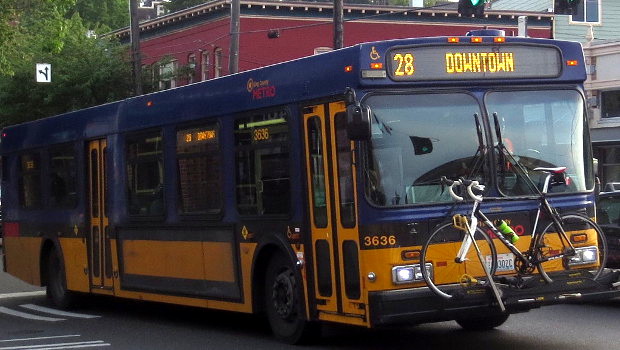If you can’t bike to work … bus!

As we close out National Bike Month, Michelle Chapdelaine has a confession: She’s never biked to work. And she doesn't feel compelled to try.
I’m a University of Washington student with a part-time job at Group Health Research Institute. On days I have classes, I happily hop on my bike—the ride to campus is four miles round-trip from my house, almost entirely on a bike trail, and takes half the time of a bus trip. But when I think about biking to GHRI, I anticipate a longer trip (I’m not a very speedy cyclist), a change of clothes, and arriving in time to take a shower, not to mention gnarly traffic and distracted drivers. For me, the benefits of biking to work don’t outweigh what I see as added hassle and time.
 |
| Michelle Chapdelaine |
If you've been thinking about trying a two-wheeled commute, go for it! May seems like the perfect month to give it a spin. But I want to plug the health benefits of another common mode of transportation: your local bus system. Taking the bus isn't going to get your blood pumping the way a bike commute would, but compared to driving, public transportation is the healthier choice. Here are some reasons why:
- Taking a bus or train almost always means walking to and from the stop. People who take transit are multitasking by getting some physical activity while they travel from Point A to Point B. Studies have shown that a substantial portion of transit users meet the Surgeon General’s daily physical activity recommendation just by walking to and from transit, and that transit users have overall higher daily rates of physical activity than non-transit users.
- Public transportation is good for the environment. If you take the bus instead of driving, you’re conserving energy and reducing your carbon footprint.
- Long driving commutes are not good for your health. Even if you’re stuck in traffic on the bus, at least you’re not behind the wheel! And instead of playing Angry Birds, you could try some de-stressing techniques with meditation apps like Calm.
- If you’re on a crowded bus, you may not get a seat—but chances are, that’s not the worst thing! If your job puts you on your butt in front of a computer for hours each day, standing on the bus is an opportunity to delay the inevitable sedentary part of your day.
While biking to work is a great habit, it’s not for everyone. Luckily, public transit can help you incorporate more physical activity into your day, and is better for the environment than single-occupancy vehicles. And in King and Kitsap counties of Washington State, the bus is becoming even more accessible, thanks to a program that reduces fares for low-income earners.
If you aren’t already a regular bus commuter, make a commitment to increase your bus-to-work days this month, or take the bus somewhere you would normally drive. And remember, if you started a bike ride and changed your mind, in many areas of the country, including Seattle, you can always load your bike on a bus rack and try again tomorrow.
Michelle Chapdelaine is a Research Specialist with the Center for Community Health and Evaluation at GHRI, and an MPH student at the University of Washington School of Public Health.


